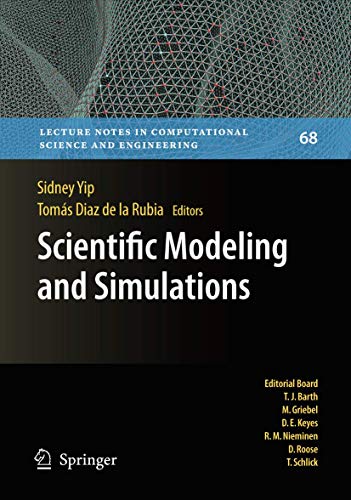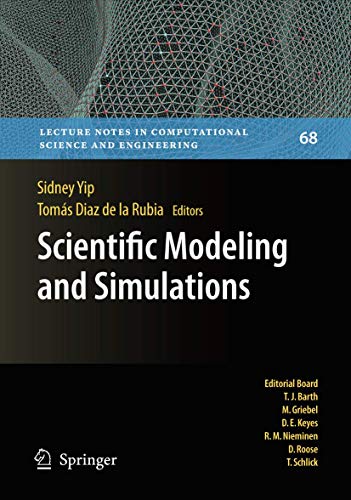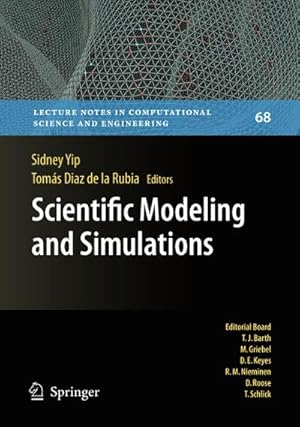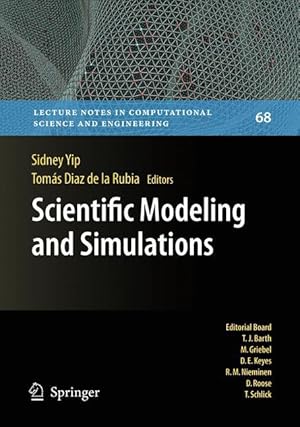scientific modeling simulations (23 risultati)
Filtri di ricerca
Tipo di articolo
- Tutti i tipi di prodotto
- Libri (23)
- Riviste e Giornali (Nessun altro risultato corrispondente a questo perfezionamento)
- Fumetti (Nessun altro risultato corrispondente a questo perfezionamento)
- Spartiti (Nessun altro risultato corrispondente a questo perfezionamento)
- Arte, Stampe e Poster (Nessun altro risultato corrispondente a questo perfezionamento)
- Fotografie (Nessun altro risultato corrispondente a questo perfezionamento)
- Mappe (Nessun altro risultato corrispondente a questo perfezionamento)
- Manoscritti e Collezionismo cartaceo (Nessun altro risultato corrispondente a questo perfezionamento)
Condizioni Maggiori informazioni
- Nuovo (19)
- Come nuovo, Ottimo o Quasi ottimo (4)
- Molto buono o Buono (Nessun altro risultato corrispondente a questo perfezionamento)
- Discreto o Mediocre (Nessun altro risultato corrispondente a questo perfezionamento)
- Come descritto (Nessun altro risultato corrispondente a questo perfezionamento)
Legatura
Ulteriori caratteristiche
- Prima ed. (Nessun altro risultato corrispondente a questo perfezionamento)
- Copia autograf. (Nessun altro risultato corrispondente a questo perfezionamento)
- Sovracoperta (Nessun altro risultato corrispondente a questo perfezionamento)
- Con foto (12)
- Non Print on Demand (15)
Lingua (1)
Prezzo
- Qualsiasi prezzo
- Inferiore a EUR 20 (Nessun altro risultato corrispondente a questo perfezionamento)
- EUR 20 a EUR 45 (Nessun altro risultato corrispondente a questo perfezionamento)
- Superiore a EUR 45
Spedizione gratuita
Paese del venditore
Valutazione venditore
-
EUR 104,84
Convertire valutaEUR 2,27 per la spedizione in U.S.A.Quantità: Più di 20 disponibili
Aggiungi al carrelloCondizione: New.
-
Scientific Modeling and Simulations (Lecture Notes in Computational Science and Engineering, 68)
Da: Lucky's Textbooks, Dallas, TX, U.S.A.
EUR 103,65
Convertire valutaEUR 3,43 per la spedizione in U.S.A.Quantità: Più di 20 disponibili
Aggiungi al carrelloCondizione: New.
-
Scientific Modeling and Simulations (Hardcover)
Editore: Springer-Verlag New York Inc., New York, NY, 2009
ISBN 10: 1402097409 ISBN 13: 9781402097409
Lingua: Inglese
Da: Grand Eagle Retail, Bensenville, IL, U.S.A.
EUR 118,52
Convertire valutaGratis per la spedizione in U.S.A.Quantità: 1 disponibili
Aggiungi al carrelloHardcover. Condizione: new. Hardcover. Although computational modeling and simulation of material deformation was initiated with the study of structurally simple materials and inert environments, there is an increasing demand for predictive simulation of more realistic material structure and physical conditions. In particular, it is recognized that applied mechanical force can plausibly alter chemical reactions inside materials or at material interfaces, though the fundamental reasons for this chemomechanical coupling are studied in a material-speci c manner. Atomistic-level s- ulations can provide insight into the unit processes that facilitate kinetic reactions within complex materials, but the typical nanosecond timescales of such simulations are in contrast to the second-scale to hour-scale timescales of experimentally accessible or technologically relevant timescales. Further, in complex materials these key unit processes are rare events due to the high energy barriers associated with those processes. Examples of such rare events include unbinding between two proteins that tether biological cells to extracellular materials [1], unfolding of complex polymers, stiffness and bond breaking in amorphous glass bers and gels [2], and diffusive hops of point defects within crystalline alloys [3]. Although computational modeling and simulation of material deformation was initiated with the study of structurally simple materials and inert environments, there is an increasing demand for predictive simulation of more realistic material structure and physical conditions. Shipping may be from multiple locations in the US or from the UK, depending on stock availability.
-
EUR 122,55
Convertire valutaEUR 2,27 per la spedizione in U.S.A.Quantità: Più di 20 disponibili
Aggiungi al carrelloCondizione: As New. Unread book in perfect condition.
-
Scientific Modeling and Simulations (Lecture Notes in Computational Science and Engineering, 68)
Da: Ria Christie Collections, Uxbridge, Regno Unito
EUR 111,60
Convertire valutaEUR 13,79 per la spedizione da Regno Unito a U.S.A.Quantità: Più di 20 disponibili
Aggiungi al carrelloCondizione: New. In.
-
EUR 111,59
Convertire valutaEUR 17,27 per la spedizione da Regno Unito a U.S.A.Quantità: Più di 20 disponibili
Aggiungi al carrelloCondizione: New.
-
EUR 127,72
Convertire valutaEUR 17,27 per la spedizione da Regno Unito a U.S.A.Quantità: Più di 20 disponibili
Aggiungi al carrelloCondizione: As New. Unread book in perfect condition.
-
EUR 57,74
Convertire valutaEUR 105,00 per la spedizione da Germania a U.S.A.Quantità: 1 disponibili
Aggiungi al carrelloCondizione: Sehr gut. Zustand: Sehr gut | Sprache: Englisch | Produktart: Bücher.
-
Scientific Modeling and Simulations (Lecture Notes in Computational Science and Engineering)
Da: Revaluation Books, Exeter, Regno Unito
EUR 157,19
Convertire valutaEUR 14,39 per la spedizione da Regno Unito a U.S.A.Quantità: 2 disponibili
Aggiungi al carrelloHardcover. Condizione: Brand New. 1st edition. 402 pages. 9.65x6.10x1.38 inches. In Stock.
-
Scientific Modeling and Simulations
Editore: Springer Netherlands, Springer Netherlands Mär 2009, 2009
ISBN 10: 1402097409 ISBN 13: 9781402097409
Lingua: Inglese
Da: buchversandmimpf2000, Emtmannsberg, BAYE, Germania
EUR 106,99
Convertire valutaEUR 60,00 per la spedizione da Germania a U.S.A.Quantità: 2 disponibili
Aggiungi al carrelloBuch. Condizione: Neu. Neuware -Although computational modeling and simulation of material deformation was initiated with the study of structurally simple materials and inert environments, there is an increasing demand for predictive simulation of more realistic material structure and physical conditions. In particular, it is recognized that applied mechanical force can plausibly alter chemical reactions inside materials or at material interfaces, though the fundamental reasons for this chemomechanical coupling are studied in a material-speci c manner. Atomistic-level s- ulations can provide insight into the unit processes that facilitate kinetic reactions within complex materials, but the typical nanosecond timescales of such simulations are in contrast to the second-scale to hour-scale timescales of experimentally accessible or technologically relevant timescales. Further, in complex materials these key unit processes are ¿rare events¿ due to the high energy barriers associated with those processes. Examples of such rare events include unbinding between two proteins that tether biological cells to extracellular materials [1], unfolding of complex polymers, stiffness and bond breaking in amorphous glass bers and gels [2], and diffusive hops of point defects within crystalline alloys [3].Springer Verlag GmbH, Tiergartenstr. 17, 69121 Heidelberg 408 pp. Englisch.
-
Scientific Modeling and Simulations
Editore: Springer Netherlands, Springer Netherlands, 2010
ISBN 10: 9048181976 ISBN 13: 9789048181971
Lingua: Inglese
Da: AHA-BUCH GmbH, Einbeck, Germania
EUR 114,36
Convertire valutaEUR 63,45 per la spedizione da Germania a U.S.A.Quantità: 1 disponibili
Aggiungi al carrelloTaschenbuch. Condizione: Neu. Druck auf Anfrage Neuware - Printed after ordering - Although computational modeling and simulation of material deformation was initiated with the study of structurally simple materials and inert environments, there is an increasing demand for predictive simulation of more realistic material structure and physical conditions. In particular, it is recognized that applied mechanical force can plausibly alter chemical reactions inside materials or at material interfaces, though the fundamental reasons for this chemomechanical coupling are studied in a material-speci c manner. Atomistic-level s- ulations can provide insight into the unit processes that facilitate kinetic reactions within complex materials, but the typical nanosecond timescales of such simulations are in contrast to the second-scale to hour-scale timescales of experimentally accessible or technologically relevant timescales. Further, in complex materials these key unit processes are 'rare events' due to the high energy barriers associated with those processes. Examples of such rare events include unbinding between two proteins that tether biological cells to extracellular materials [1], unfolding of complex polymers, stiffness and bond breaking in amorphous glass bers and gels [2], and diffusive hops of point defects within crystalline alloys [3].
-
Scientific Modeling and Simulations
Editore: Springer Netherlands, Springer Netherlands, 2009
ISBN 10: 1402097409 ISBN 13: 9781402097409
Lingua: Inglese
Da: AHA-BUCH GmbH, Einbeck, Germania
EUR 114,36
Convertire valutaEUR 64,25 per la spedizione da Germania a U.S.A.Quantità: 1 disponibili
Aggiungi al carrelloBuch. Condizione: Neu. Druck auf Anfrage Neuware - Printed after ordering - Although computational modeling and simulation of material deformation was initiated with the study of structurally simple materials and inert environments, there is an increasing demand for predictive simulation of more realistic material structure and physical conditions. In particular, it is recognized that applied mechanical force can plausibly alter chemical reactions inside materials or at material interfaces, though the fundamental reasons for this chemomechanical coupling are studied in a material-speci c manner. Atomistic-level s- ulations can provide insight into the unit processes that facilitate kinetic reactions within complex materials, but the typical nanosecond timescales of such simulations are in contrast to the second-scale to hour-scale timescales of experimentally accessible or technologically relevant timescales. Further, in complex materials these key unit processes are 'rare events' due to the high energy barriers associated with those processes. Examples of such rare events include unbinding between two proteins that tether biological cells to extracellular materials [1], unfolding of complex polymers, stiffness and bond breaking in amorphous glass bers and gels [2], and diffusive hops of point defects within crystalline alloys [3].
-
EUR 82,40
Convertire valutaEUR 105,00 per la spedizione da Germania a U.S.A.Quantità: 1 disponibili
Aggiungi al carrelloCondizione: Sehr gut. Zustand: Sehr gut | Sprache: Englisch | Produktart: Bücher.
-
EUR 180,67
Convertire valutaEUR 14,39 per la spedizione da Regno Unito a U.S.A.Quantità: 1 disponibili
Aggiungi al carrelloPaperback. Condizione: Brand New. 402 pages. 9.25x6.10x0.97 inches. In Stock.
-
Scientific Modeling and Simulations (Hardcover)
Editore: Springer-Verlag New York Inc., New York, NY, 2009
ISBN 10: 1402097409 ISBN 13: 9781402097409
Lingua: Inglese
Da: AussieBookSeller, Truganina, VIC, Australia
EUR 198,55
Convertire valutaEUR 31,77 per la spedizione da Australia a U.S.A.Quantità: 1 disponibili
Aggiungi al carrelloHardcover. Condizione: new. Hardcover. Although computational modeling and simulation of material deformation was initiated with the study of structurally simple materials and inert environments, there is an increasing demand for predictive simulation of more realistic material structure and physical conditions. In particular, it is recognized that applied mechanical force can plausibly alter chemical reactions inside materials or at material interfaces, though the fundamental reasons for this chemomechanical coupling are studied in a material-speci c manner. Atomistic-level s- ulations can provide insight into the unit processes that facilitate kinetic reactions within complex materials, but the typical nanosecond timescales of such simulations are in contrast to the second-scale to hour-scale timescales of experimentally accessible or technologically relevant timescales. Further, in complex materials these key unit processes are rare events due to the high energy barriers associated with those processes. Examples of such rare events include unbinding between two proteins that tether biological cells to extracellular materials [1], unfolding of complex polymers, stiffness and bond breaking in amorphous glass bers and gels [2], and diffusive hops of point defects within crystalline alloys [3]. Although computational modeling and simulation of material deformation was initiated with the study of structurally simple materials and inert environments, there is an increasing demand for predictive simulation of more realistic material structure and physical conditions. Shipping may be from our Sydney, NSW warehouse or from our UK or US warehouse, depending on stock availability.
-
Scientific Modeling and Simulations (eng)
Da: Brook Bookstore On Demand, Napoli, NA, Italia
EUR 86,24
Convertire valutaEUR 6,80 per la spedizione da Italia a U.S.A.Quantità: Più di 20 disponibili
Aggiungi al carrelloCondizione: new. Questo è un articolo print on demand.
-
Scientific Modeling and Simulations (eng)
Da: Brook Bookstore On Demand, Napoli, NA, Italia
EUR 86,24
Convertire valutaEUR 8,00 per la spedizione da Italia a U.S.A.Quantità: Più di 20 disponibili
Aggiungi al carrelloCondizione: new. Questo è un articolo print on demand.
-
Scientific Modeling and Simulations
Editore: Springer Netherlands Mrz 2009, 2009
ISBN 10: 1402097409 ISBN 13: 9781402097409
Lingua: Inglese
Da: BuchWeltWeit Ludwig Meier e.K., Bergisch Gladbach, Germania
EUR 106,99
Convertire valutaEUR 23,00 per la spedizione da Germania a U.S.A.Quantità: 2 disponibili
Aggiungi al carrelloBuch. Condizione: Neu. This item is printed on demand - it takes 3-4 days longer - Neuware -Although computational modeling and simulation of material deformation was initiated with the study of structurally simple materials and inert environments, there is an increasing demand for predictive simulation of more realistic material structure and physical conditions. In particular, it is recognized that applied mechanical force can plausibly alter chemical reactions inside materials or at material interfaces, though the fundamental reasons for this chemomechanical coupling are studied in a material-speci c manner. Atomistic-level s- ulations can provide insight into the unit processes that facilitate kinetic reactions within complex materials, but the typical nanosecond timescales of such simulations are in contrast to the second-scale to hour-scale timescales of experimentally accessible or technologically relevant timescales. Further, in complex materials these key unit processes are 'rare events' due to the high energy barriers associated with those processes. Examples of such rare events include unbinding between two proteins that tether biological cells to extracellular materials [1], unfolding of complex polymers, stiffness and bond breaking in amorphous glass bers and gels [2], and diffusive hops of point defects within crystalline alloys [3]. 408 pp. Englisch.
-
Scientific Modeling and Simulations
Da: moluna, Greven, Germania
EUR 92,27
Convertire valutaEUR 48,99 per la spedizione da Germania a U.S.A.Quantità: Più di 20 disponibili
Aggiungi al carrelloCondizione: New. Dieser Artikel ist ein Print on Demand Artikel und wird nach Ihrer Bestellung fuer Sie gedruckt. Showcases cutting-edge applications of modeling and computations to formidable research problems relevant to our society.Highlights the benefits of cross-fertilization between computational science and other research communities.Although c.
-
Scientific Modeling and Simulations
Da: moluna, Greven, Germania
EUR 92,27
Convertire valutaEUR 48,99 per la spedizione da Germania a U.S.A.Quantità: Più di 20 disponibili
Aggiungi al carrelloCondizione: New. Dieser Artikel ist ein Print on Demand Artikel und wird nach Ihrer Bestellung fuer Sie gedruckt. Showcases cutting-edge applications of modeling and computations to formidable research problems relevant to our society.Highlights the benefits of cross-fertilization between computational science and other research communities.Although c.
-
Scientific Modeling and Simulations
Editore: Springer-Verlag New York Inc., 2009
ISBN 10: 1402097409 ISBN 13: 9781402097409
Lingua: Inglese
Da: THE SAINT BOOKSTORE, Southport, Regno Unito
EUR 137,05
Convertire valutaEUR 22,46 per la spedizione da Regno Unito a U.S.A.Quantità: Più di 20 disponibili
Aggiungi al carrelloHardback. Condizione: New. This item is printed on demand. New copy - Usually dispatched within 5-9 working days 876.
-
Scientific Modeling and Simulations
Editore: Springer Netherlands, Springer Netherlands Okt 2010, 2010
ISBN 10: 9048181976 ISBN 13: 9789048181971
Lingua: Inglese
Da: buchversandmimpf2000, Emtmannsberg, BAYE, Germania
EUR 106,99
Convertire valutaEUR 60,00 per la spedizione da Germania a U.S.A.Quantità: 1 disponibili
Aggiungi al carrelloTaschenbuch. Condizione: Neu. This item is printed on demand - Print on Demand Titel. Neuware -Although computational modeling and simulation of material deformation was initiated with the study of structurally simple materials and inert environments, there is an increasing demand for predictive simulation of more realistic material structure and physical conditions. In particular, it is recognized that applied mechanical force can plausibly alter chemical reactions inside materials or at material interfaces, though the fundamental reasons for this chemomechanical coupling are studied in a material-speci c manner. Atomistic-level s- ulations can provide insight into the unit processes that facilitate kinetic reactions within complex materials, but the typical nanosecond timescales of such simulations are in contrast to the second-scale to hour-scale timescales of experimentally accessible or technologically relevant timescales. Further, in complex materials these key unit processes are ¿rare events¿ due to the high energy barriers associated with those processes. Examples of such rare events include unbinding between two proteins that tether biological cells to extracellular materials [1], unfolding of complex polymers, stiffness and bond breaking in amorphous glass bers and gels [2], and diffusive hops of point defects within crystalline alloys [3].Springer Verlag GmbH, Tiergartenstr. 17, 69121 Heidelberg 408 pp. Englisch.
-
Scientific Modeling and Simulations
Editore: Springer Netherlands Okt 2010, 2010
ISBN 10: 9048181976 ISBN 13: 9789048181971
Lingua: Inglese
Da: BuchWeltWeit Ludwig Meier e.K., Bergisch Gladbach, Germania
EUR 149,79
Convertire valutaEUR 23,00 per la spedizione da Germania a U.S.A.Quantità: 2 disponibili
Aggiungi al carrelloTaschenbuch. Condizione: Neu. This item is printed on demand - it takes 3-4 days longer - Neuware -Although computational modeling and simulation of material deformation was initiated with the study of structurally simple materials and inert environments, there is an increasing demand for predictive simulation of more realistic material structure and physical conditions. In particular, it is recognized that applied mechanical force can plausibly alter chemical reactions inside materials or at material interfaces, though the fundamental reasons for this chemomechanical coupling are studied in a material-speci c manner. Atomistic-level s- ulations can provide insight into the unit processes that facilitate kinetic reactions within complex materials, but the typical nanosecond timescales of such simulations are in contrast to the second-scale to hour-scale timescales of experimentally accessible or technologically relevant timescales. Further, in complex materials these key unit processes are 'rare events' due to the high energy barriers associated with those processes. Examples of such rare events include unbinding between two proteins that tether biological cells to extracellular materials [1], unfolding of complex polymers, stiffness and bond breaking in amorphous glass bers and gels [2], and diffusive hops of point defects within crystalline alloys [3]. 408 pp. Englisch.















